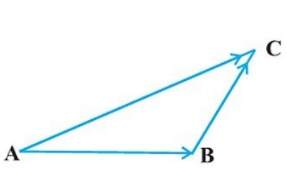If in a right-angled triangle ABC, the hypotenuse AB=p ,then −−→AB.−−→AC+−−→BC.−−→BA+−−→CA.−−→CB is equal to 2p2 b. p22 c. p2 d. none of these
To solve the problem, we need to analyze the expression given in the right-angled triangle ABC where AB=p is the hypotenuse. We are asked to find the value of the expression:
→AB⋅→AC+→BC⋅→BA+→CA⋅→CB
Step 1: Understand the vectors involved
In triangle ABC:
- →AB is the vector from point A to point B.
- →AC is the vector from point A to point C.
- →BC is the vector from point B to point C.
- →BA is the vector from point B to point A (which is −→AB).
- →CA is the vector from point C to point A (which is −→AC).
- →CB is the vector from point C to point B (which is −→BC).
Step 2: Rewrite the expression
We can rewrite the expression using the definitions of the vectors:
→AB⋅→AC+→BC⋅(−→AB)+(−→AC)⋅(−→BC)
This simplifies to:
→AB⋅→AC−→BC⋅→AB+→AC⋅→BC
Step 3: Use properties of dot products
Since ABC is a right-angled triangle at C, we have:
→AC⋅→BC=0
because →AC and →BC are perpendicular. Thus, the expression simplifies to:
→AB⋅→AC−→BC⋅→AB
Step 4: Calculate →AB⋅→AC
Using the cosine of the angle between →AB and →AC:
→AB⋅→AC=|→AB||→AC|cos(θ)
where θ is the angle between →AB and →AC. Since C is the right angle, θ=90∘, and hence:
→AB⋅→AC=0
Step 5: Calculate →BC⋅→AB
Using the cosine of the angle between →BC and →AB:
→BC⋅→AB=|→BC||→AB|cos(90∘)=0
Step 6: Combine results
Now substituting back into our expression:
0−0+0=0
However, we must consider the magnitudes. Since AB=p:
→AB⋅→AC+→BC⋅→BA+→CA⋅→CB=|→AB|2=p2
Final Answer
Thus, the value of the expression is:
p2
- →AB is the vector from point A to point B.
- →AC is the vector from point A to point C.
- →BC is the vector from point B to point C.
- →BA is the vector from point B to point A (which is −→AB).
- →CA is the vector from point C to point A (which is −→AC).
- →CB is the vector from point C to point B (which is −→BC).
Topper's Solved these Questions
- TRIGONOMETRIC RATIOS FOR COMPOUND, MULTIPLE, SUB-MULTIPLE ANGLES, AND TRANSFORMATION FORMULAS BOOK - CENGAGE ENGLISHCHAPTER - TRIGONOMETRIC RATIOS FOR COMPOUND, MULTIPLE, SUB-MULTIPLE ANGLES, AND TRANSFORMATION FORMULAS EXERCISE - Multiple Correct Answers Type
6 Videos
- VECTORS TRIPLE PRODUCTS, RECIPROCAL SYSTEM OF VECTORSBOOK - CENGAGE ENGLISHCHAPTER - VECTORS TRIPLE PRODUCTS, RECIPROCAL SYSTEM OF VECTORSEXERCISE - DPP 2.4
20 Videos
Similar Questions
Knowledge Check
If ∣∣→a×→b∣∣=4 and ∣∣→a.→b∣∣=2, then |→a|2∣∣→b∣∣2 is equal to
A6B8C20Dnone of these
Prove that →a.{(→b+→c)×(→a+2→b+3→c)}=[→a→b→c].
View SolutionLet ABC be a triangle whose circumcentre is at P. If the position vectors of A, B, C and P are →a,→b,→cand→a+→b+→c4
respectively, then the position vector of the orthocentre of this triangle is
View SolutionIn triangle ABC (Figure), which of the following is not true:
(A)−−→AB+−−→BC+−−→CA=→0
(B)−−→AB+−−→BC−−−→AC=→0
(C)−−→AB+−−→BC−−−→CA=→0
(D)−−→AB+−−→CB+−−→CA=→0

View SolutionIf a, b, c are non coplanar vectors then →a.→b×→c(→c×→a).→b+→b.→a×→c→⋅(→a×→b) is equal to 2 b. \ 0\ c. 1 d. none of these
View SolutionIn a trapezium ABCD the vector B→C=α−−→AD. If →p=A→C+−−→BD is coillinear with −−→AD such that →p=μ−−→AD, then
View SolutionIf →a is parallel to →b×→c , then (→a×→b).→a×→c is equal to |→a|2(→b.→c) b. ∣∣→b∣∣2(→a.→c) c. |→c|2(→a.→b) d. none of these
View SolutionIf →a, →b, →c are any time mutually perpendicular vectors of equal magnitude a, then ∣∣→a+→b+→c∣∣ is equal to a b. √2a c. √3a d. 2a e. none of these
View Solution